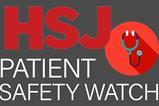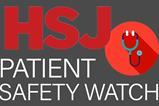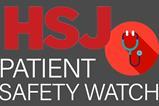HSJ is now hosting the Patient Safety Watch newsletter, written by Patient Safety Watch chief executive James Titcombe.
Good afternoon and welcome to this fortnight’s Patient Safety Watch newsletter. In this edition, we share a guest blog by parliamentary and health service ombudsman Rob Behrens, who reflects on his time since being appointed the role in 2017; both the progress that’s been made and the continuing struggle for further change.
Before sharing Rob’s blog, here is the usual roundup of Patient Safety news from the past fortnight.
MPs call on government to address ‘appalling’ maternal health disparities
A report by the Commons women and equalities committee has warned black women are four times more likely to die from childbirth than white women, while women from the most deprived areas are two-and-a-half times more likely to die than those in the least. The MPs called the government’s and NHS’s effort to address such disparities “necessary but insufficient”, adding both had “underestimated” to what extent racism played a role.
“Government must be more ambitious and set a national target to end disparities,” added the committee’s chair, Caroline Nokes. “It is frankly shameful that we have known about these disparities for at least 20 years. It cannot take another 20 to resolve.”
I can only echo Caroline Nokes in saying that “shameful” feels like exactly the right word here – much more must clearly be done to change these appalling statistics.
The cost of harm in maternity services more than twice the cost of care itself
Staying on the theme of maternity safety, independent research by the charity Baby Lifeline and analysis by The Times, published last week, highlighted that the cost of compensating mothers and their families for harm caused by NHS maternity care is more than double what the health service spends on providing maternity services each year.
The Times reported that NHS England spends £3bn annually on maternity and neonatal services, and the total cost of harm (defined as the current value of the estimated cost of claims expected or received from incidents in the financial year) was £8.16bn in 2021-22.
That is a big number to comprehend. By the time it takes you to read this newsletter (let’s assume it takes you 10 minutes), another £155k will have been added to the maternity litigation bill. The costs are staggering, but behind the numbers are lives that have been devastated and forever changed in circumstances where safer care could have avoided such an outcome.
Regular readers of this newsletter, we know that stories about maternity safety are a regular feature. The ethical case for improving maternity safety is well-evidenced and understood, but surely these figures highlight that investing to improve maternity safety and prevent harm in the first place is an urgent economic as well as a moral imperative.
If we invested just a quarter of that £8.16bn in workforce recruitment and retention, leadership, training and better systems to support the spread and adoption of best practice across the maternity system, how much harm (and associated litigation costs) could be prevented?
‘It’s where she should have been safe’
In other news this fortnight, mental healthcare services provided by the Priory Group have been in the spotlight.
Beth Matthews was 26 when she took her life by purchasing poison online and then taking it in front of staff at the Priory Hospital Cheadle Royal in Manchester. Her death – as well as that of two other young women who died at the hospital in the space of eight weeks – raised questions about how such a case should have been able to happen. Speaking to The Sunday Times, her sister Lucy recalled how Beth had felt the hospital would “stop” her, adding: “It scares me that there are still patients in there. It is where she should have been safe.”
The newspaper reported an internal investigation by the hospital group had found there was an “inconsistent approach” to Ms Matthew’s care plan regarding her not being allowed to open her post while, in response to a coroner’s finding of “suicide contributed to by neglect”, it said: “On the balance of probabilities, if the measure related to post on Beth’s care plan was followed, she would not have ingested the substance, and would not have died as she did.”
Thoughts are with Beth’s family and I hope that this tragic case will lead to system-wide learning.
Why are hundreds of people going blind?
Late last month, it was revealed hundreds of people in the UK are going blind due to delayed appointments. Now, the University of Edinburgh’s chair of global public health and Guardian columnist regular Devi Sridhar – as well as her US-based ophthalmologist brother – asks “why”.
She points out that, while treatment is widely available for many common blindness-causing conditions, growing waiting lists for non-emergency care are making it harder for people to access them in a timely manner.
She continues that policy has also shifted away from preventive care towards acute, “so, instead of preventing someone becoming sick in the first place through primary and community-based care, the NHS steps in when someone is already ill and needing hospital admission”.
“Prevention” was once a key policy focus for the future of the NHS, yet in the post-pandemic world, it is feeling increasingly clear that in too many areas, the NHS is now getting it wrong.
Top-down pressure to cancel planned workforce increases
Continuing on a related theme, worryingly this week, HSJ has reported that NHS leaders have raised concerns that NHSE and the government were treating money as the “first priority”, quoting an anonymous director saying “The tone of the conversation [with NHSE about finance] has become intimidating and I worry that this will lead boards to take unsafe risks, and head into Mid Staffs territory.”
HHS report that several NHS trusts have been told that they were “…not permitted to increase their total number of planned posts… for 2023-24.”
If there was one overriding lesson from the history of patient safety in the NHS, it is that top-down pressure to prioritise finances above the fundamentals of safe care, can have disastrous consequences. We also know that unsafe care is invariably the most expensive and that a short-term focus on finance, in the longer term, often achieves the very opposite results.
The lessons from Mid Staffs were hard won and painful. In 2023, surely, it is imperative that we avoid learning the same lessons the hard way again?
Sharing some good stuff…
Share your work at #MatSafety2023
Baby Lifeline is pleased to announce that its fourth annual National Maternity Safety Conference will take place on Thursday 21 September 2023 in Birmingham.
Baby Lifeline is keen to showcase best practice in maternity care and is pleased to welcome poster presentation abstracts. This year, successful applicants may also be invited to give an oral presentation. The organisers are particularly keen to hear about maternity service quality improvement measures which speak to one or more of the following themes: listening to families and staff; promoting safety culture; teamworking; and reducing mortality and morbidity.
For more information, to submit your abstract, and to book your place, visit the Baby Lifeline website here.
Being Fair
In case anyone missed it, NHS Resolution published their report Being Fair 2 at the end of last month. The report contains information, guidance and tools to help NHS organisations promote and embed a person-centred workplace that is “…compassionate, safe and fair”. Promoting a just and learning culture in the NHS is a key part of the national patient safety strategy and those working in this area might find that the model Just and Learning Culture Charter included in the report, particularly useful.
That’s all from me for this edition, please do read the insightful blog from Rob Brehens below and look out for our next edition in two weeks time. Thanks for reading and stay safe.
James Titcombe
The struggle continues, by Rob Behrens
The omens were not good in 2017 when I was appointed as parliamentary and health service ombudsman.
In addition to a 24 per cent budget cut prompting an exodus to Manchester, there was published ministerial displeasure at the insensitive way in which PHSO dealt with families who had lost children in the health service. In addition, staff morale was very low.
What transpired from a long consultation to create consensus about the way forward and the values associated with that path was a strategic agenda rooted in professional development for all staff, and a commitment to the principle of transparency with the ambition (now achieved) of publishing casework outcomes.
There was also an engagement with service providers on the fundamentals of effective complaints handling on the frontline of service delivery.
The significant achievements in professional development included a portfolio of professional training to promote better investigations and aligned to patient safety issues, the requirement that senior caseworkers be accredited to demonstrate their competence, and the creation of an Ombudsman Academy (the first in Europe) to oversee the development of a generation of new case handlers as the office expanded and most casework staff moved to Manchester.
The biggest challenge here was to address the significance of patient safety as a central strand in ombudsman work. I commissioned Sir Liam Donaldson, formerly the chief medical officer and not known for his reticence, to review independently the clinical advice function of the ombudsman service.
In his view, external clinical advisers were too peripheral to the investigation process and should test and challenge the views of case handlers without departing from their advisory role. He also thought that the clinical advice team required decisive professional leadership from an inhouse clinician to align it more effectively to the Ombudsman’s patient safety agenda. In terms of developing trust, he wanted complainants to be able to see the clinical advice that was provided.
All but the last of these recommendations have been implemented. The result is the national ombudsman service having the capacity to make more rigorous decisions about individual cases involving patient safety. We have supplemented Sir Liam’s work with the creation of both a working group of ombudsman and deputy ombudsman leaders to have close oversight of complex cases and a small expert advisory panel to give supplementary advice.
Further, we now have the organisational coherence to make interventions in systemic patient safety issues. This has led (for example) to our regular engagement with health service regulators, and given us the confidence to trigger publicly the Emerging Concerns Protocol over long failures at University Hospitals Birmingham Trust to place patient safety above its own reputation.
We have also used ombudsman clinical expertise to point to failures in imaging services in the NHS and to detail in accessible fashion of the adverse lived experiences of women in childbirth and under perinatal care and we are poised to make an evidence-based contribution to the national covid inquiry, where we will draw attention to malfunctioning of Do Not Resuscitate procedures remote access to care and poor communication with patients.
Is PHSO then the exemplary ombudsman service it set out to become in its 2018 corporate strategy? Five years down the line, and in the opinion of international ombudsman peer review, the answer is “not yet” but that we are well on the way. The latest peer review by counterparts in Greece, Israel, and the Housing Ombudsman Service in England pointed to significant success in reviving staff morale and engagement.
But, they returned to the point about the sorry refusal of ministers to provide time for legislative reform to develop our mandate in a way which would contribute substantially to addressing continuing issues of patient safety.
Two, much needed, reforms stand out. The first is the creation of a single public service Ombudsman for England uniting at commencement PHSO with the Local Government and Social Care Ombudsman. This integration would join up the oversight and investigation of health and social care complaints under one roof. When established it would make much clearer where to go to complain.
Equally important and routine across Europe are the powers of “Own Initiative” which give ombudsman offices the opportunity to investigate issues not directly complained about. By contrast, our own investigation into the deaths of young people in an Essex mental health facility was severely constrained by our inability to look at the substantial number of cases where the families of those who died had not complained.
In all these circumstances, the national ombudsman in the UK stands recrudescent and up for the fight, but impaired by government inaction on the legislative front. And it is impaired at a time when it is most needed. Public satisfaction with the NHS is at its lowest recorded level.
This is contextualised by a variable health service culture which, when patient safety is at stake, too often prefers turning on whistleblowers, to preserve organisational reputation. The challenge to the national Ombudsman is to continue to work independently, impartially and in evidence-based fashion to “speak truth and to power” through these turbulent times. The struggle continues.
Rob Behrens, parliamentary and health service ombudsman
































1 Readers' comment